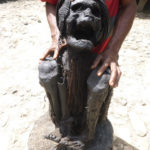 Until 1930 the central highlands of Papua were believed to be completely uninhabited. But when two Australian gold prospectors made an expedition into the western central highlands, those assumptions were shattered forever. What they found were numerous tribes speaking hundreds of different languages and who lived in such isolation that they had no concept of the outside world. Since that time the Papuan people have been thrust into modernity, sometimes not so willingly. But with an endless terrain of dense mountainous jungle, many people believe that remote tribes still live isolated and virtually uncontacted by the rest of the world. It was stories like this that sparked my interest and compelled me to dig deeper into visiting this remote mountain range.
Until 1930 the central highlands of Papua were believed to be completely uninhabited. But when two Australian gold prospectors made an expedition into the western central highlands, those assumptions were shattered forever. What they found were numerous tribes speaking hundreds of different languages and who lived in such isolation that they had no concept of the outside world. Since that time the Papuan people have been thrust into modernity, sometimes not so willingly. But with an endless terrain of dense mountainous jungle, many people believe that remote tribes still live isolated and virtually uncontacted by the rest of the world. It was stories like this that sparked my interest and compelled me to dig deeper into visiting this remote mountain range.
Finding reliable information on Papua was challenging at best. I spent months pouring over blogs, forums and articles trying to piece together a complete picture of where I wanted to go. It seemed that few people trekked independently in the area, and even fewer wrote about it. In the end, I settled on a plan to trek the Baliem Valley of the central highlands in Papua, Indonesia.
All treks in the central highlands start with a flight to Wamena, the main hub of the region. This small mountain town is the last place to stock up on basic amenities and Western style comforts, but aside from that there’s not much to keep your interest.
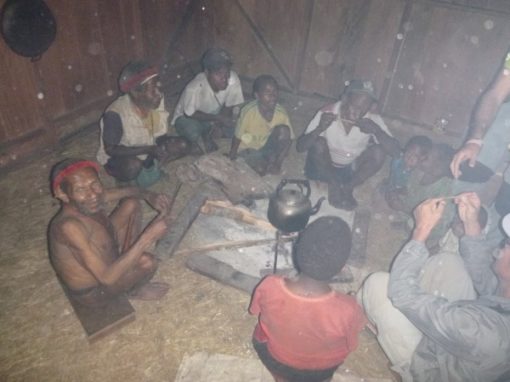 Although I made the trip alone, at my guesthouse in Wamena I met a small group of travelers who were also interested in trekking the Baliem Valley. Together, we hitchhiked to the trailhead at the village of Kurima, and from there we began our trek east into the central highland mountain range.
Although I made the trip alone, at my guesthouse in Wamena I met a small group of travelers who were also interested in trekking the Baliem Valley. Together, we hitchhiked to the trailhead at the village of Kurima, and from there we began our trek east into the central highland mountain range.
Over the next few days we hiked across the dense jungle clad mountains, doing our best to navigate the muddy and barely discernible trails. Periodically we would ask for directions from local farmers or kids who noticed us passing by. And from time to time, we would even have an entourage of children leading us between villages.
Along the way we stayed in local huts, typically maintained for passing travelers and tourists. They are generally very basic and consist of only an empty room with no running water and limited electricity. Each evening when we arrived in a new village, we’d sit around the fire eating sweet potatoes, sharing photos and sometimes playing a little music.
Our trek got us as far as the village of Ugem, at which point we decided to start circling back on the opposite side of the river valley. On the return trip, we passed through more villages where we met other foreigners on guided tours. In the end getting away from the guided treks allowed us to visit villages and meet people who lived a different version of reality than what we were accustomed to, and I think that’s what we were all hoping to find.
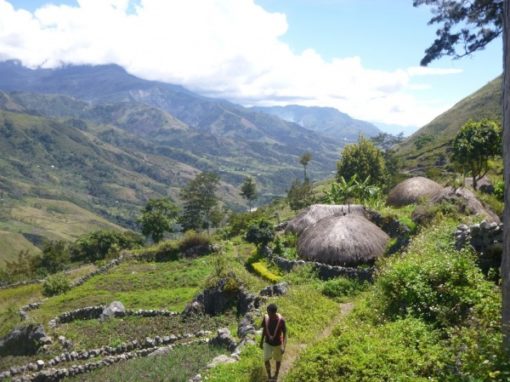 Trekking Regions:
Trekking Regions:
The central highlands are composed of a mountain range that stretches from west to east across the interior of the island of New Guinea. As a general rule, trekking routes exist where roads do not. Here’s a breakdown of the major trekking regions.
Lani Country: Located west of Wamena and connected by road, the Lani people are generally considered to be less traditional yet friendlier. By public bus you can get to the first town in Lani country (Kimbim) in about two hours. Another 12 hours or so will get you to Tiom or Karubaga where the trailheads begin.
Dani Country (Baliem Valley): It’s no surprise that the Baliem Valley is the most popular trekking destination in the central highlands. With Wamena sitting at its center, it’s the easiest area to reach. But with paved roads going north and west out of Wamena, trekking options are usually limited to the eastern areas where mountains have prevented road construction. Trailheads here start at Hitigima or Kurima, about 45 minutes from Wamena.
Yali Country: If you keep going east from Baliem Valley you’ll eventually hit Yali Country. It’s the most traditional area of the highlands and also the hardest to reach. Most travelers run out of time before making it this far. The trailhead is the same as for Baliem Valley and takes about 4/6 days to reach the first Yali settlement (Angguruk). To reach the end of Yali Country (Kosarek) it takes a total of about two weeks from Wamena.
Mek Country: Further east still, yet not necessarily more traditional, is the Mek region. This area sits up against the border with Papua New Guinea. Few travelers make it here, although there has been significant missionary involvement over past few decades making it less traditional despite is remote location.
Culture of the Papuan Central Highlands:
Although Papua is still one of the more untouched places left on earth, things are changing quickly. Traditional Papuan clothing in the central highlands usually consists of a Penis Gourd for men and a simple grass skirt for women. But these days most people choose to wear Western style clothing with a common accessory being an outdated flip phone.
Airstrips have long been a fixture across the Papuan landscape ever since Christian missionaries descended upon the island. As a result, change has come to the island faster than might normally be expected. In addition, roads are beginning to crisscross the area more and more, driven mostly by mineral exploration. However mountainous areas, which tend to keep road construction at bay, have helped limit outside influence and keep the local culture more intact in some highland areas.
The typical central highlands diet, which hasn’t changed all that much over the years, is based around the almighty sweet potato. In the highlands it seems to be the only thing eaten, aside from the rare occurrence when a pig is slaughtered. Although villages that see tourists will occasionally have ramen noodles packages available for sale.
Most Papuans living in remote villages will still use local building materials for their homes. This can be seen in the form of small huts that dot the mountainous landscape. We were even lucky enough to see the men of one village working together to build a hut for one of the elderly widows in their village. These homes usually consist of a wooden frame, a grass roof, a raised sleeping area and a fire pit in the center.
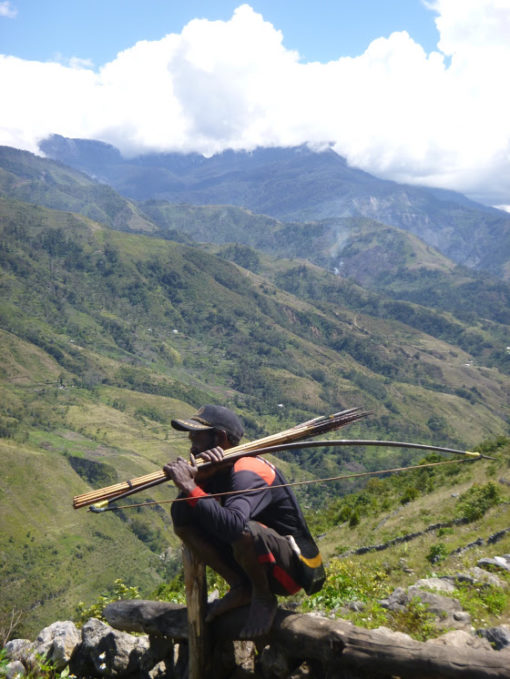 Surat Jalan (Travel Permit):
Surat Jalan (Travel Permit):
As if traveling in Papua wasn’t complicated enough, the government has decided to add an additional layer of red tape for you to cut through. Its called a “Surat Jalanâ€, and you’ll need to obtain one upon your arrival in Papua. It’s essentially a travel permit that outlines the areas that you plan to visit. Remember that many Papuans are not thrilled by the fact that they are governed by Indonesia, and as a result civil unrest means there are many areas are off-limits to foreign travelers.
The best place to get your Surat Jalan is at the Polresta (police station) in Jayapura or Wamena. The process takes about an hour but you’ll need to make sure you have your passport, visa and a passport-sized headshot available. Just be sure to list out every province and village that you plan to visit, even places that you “might†visit. It’s better to overshoot your list rather than come up short, since it costs you nothing to do so.
That being said, after I got my Surat Jalan I put it in my bag and forgot about it for the rest of the trip. I didn’t check in at local police stations and no one asked for my papers. In reality it seems more of a formality than anything else, but I had it in case I needed it. The last thing you want is to get told to turn back for not having the correct paperwork.
Getting There:
All roads to Papua start in Jakarta and eventually make their way to the island’s capital of Jayapura. Flights from Jakarta to Jayapura take anywhere from 6 to 11 hours. Garuda, Batik and Lion Air all offer flights starting at around $500 USD.
From Jayapura you’ll need to take a scenic 1-hour flight to the town of Wamena. It’s from this jumping off point that all treks begin. Flights from Jayapura to Wamena are offered by Wings, Nam and Trigana Air, but be prepared for some long delays if weather doesn’t cooperate.
Telephones:
To call the numbers below from the U.S., dial 011 (the international dialing code), +62
(Country code for Indonesia), 9 (the area code) and the local number.
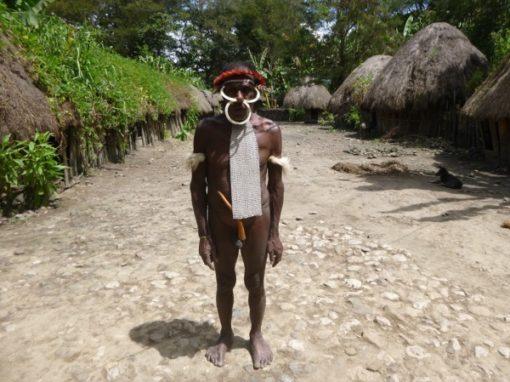 Getting Around:
Getting Around:
Wamena is small enough to traverse on foot or by local taxi. For overland travel between villages, taxis and public transit are available however transit it can be slow and inconsistent. Taxis won’t always be available in villages outside Wamena so it’s important to book one for the entire day but hitchhiking is also a common and safe way to get around in a pinch. Major towns in Papua are likely not connected by road, making air and water travel the only option for cross-country travel.
Where to stay:
Hotel Nayak; Wamena Kota, Wamena, Papua 99511, Indonesia; +62 969 31067. As the most popular budget guesthouse, this place offers clean and simple rooms in the center of town.
Baliem Valley Resort; Desa Sekan, Kecamatan Siepkosi, Jayawijaya, Pugima, Wamena, Papua, 80034, Indonesia. +62 812-4802-3489. For a rustic, upscale experience try this eco-resort about an hour east of Wamena.
Rainbow Hotel; Jl. Irian, Wamena Kota, Wamena, Papua 99511, Indonesia; +62 812-4813-7568. If a rainbow themed hotel serving food is what you’ve been after, look no further.
Where to eat:
Nasi Kuning Ternate; JI. Trikora, Wamena Kota, Wamena, Papua 99511, Indonesia; +62 852-5428-4029. This small and slightly dingy restaurant just across from the Wamena airstrip serves up quality Indonesian food.
Rumah Makan Fakhira; Jl. Jenderal Sudirman, Hurekama, Wamena, Papua 99511, Indonesia; +62 813-4482-5154. For slightly more options this place is just down the road. Deserts and juices are also available.
Pilamo Café & Bakery; Jl. Safri Darwin No.2, Wamena Kota, Wamena, Papua 99511, Indonesia; +62 969 31162. This place is worth a visit for pastries and sweets….things you wont get for quite some time if you’re heading into the mountains.

